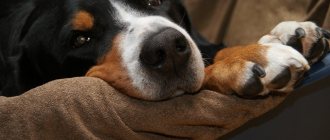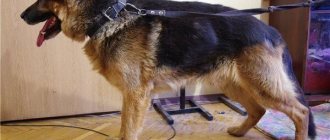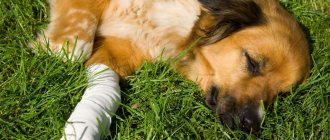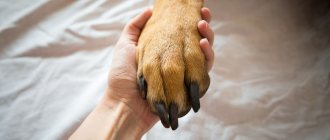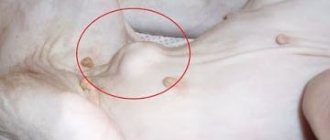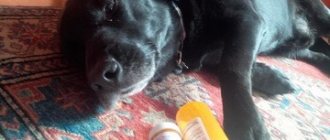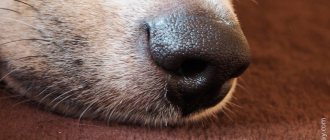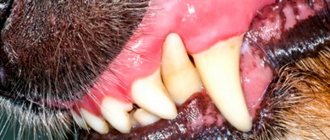Dogs spend most of their time on their feet - walking, jumping and running, so caring for your pet's paws is very important. The paw pads act as shock absorbers and protect the bones and joints of the limb. The wrist pad acts as a kind of brake and helps the dog navigate uneven surfaces.
It is important to regularly check your dog's paws for problems and take steps to keep your pet healthy. If a four-legged friend begins to limp, the owner needs to analyze the symptoms and determine the danger of the disease. At the first symptoms of paw disease in dogs, you should contact a veterinarian.
Causes of problems
Allergy
Animals with allergies experience itchy paws and tend to bite, lick or chew them.
The most unpleasant complication of allergic reactions are scratches and wounds that appear due to strong uncontrolled scratching. In some cases, excessive paw licking causes irritation or sores and the paws become more susceptible to fungal and bacterial infections.
Treatment of allergies in dogs is always complex and depends on the type of reaction and symptomatic manifestations.
Caring for your dog's paws in winter
In winter, dog paws require special attention and careful care. Chemical reagents that are thickly sprinkled on city streets, in contact with paw pads, literally eat into the skin, into small cracks and cuts, causing itching, burning, and sometimes serious inflammation. To protect your dog's paws, simply lubricate the pads and skin between the toes with protective wax every time you go for a winter walk. After a walk, the wax must be removed (just rinse the paws with warm running water).
Important:
Be careful when walking near ponds, puddles, or snow crust in winter - your dog can cut his paw on the sharp edge of the ice.
Fungal and bacterial infections
Bacterial and fungal skin infections are common in dogs and often affect the paws. Pets suffer from fungal paw infections at any age and even under the best conditions.
Many types of bacteria and fungi live on the paw pads, but sometimes these organisms get out of control and cause an infection.
The skin between the toes and other skin folds becomes itchy, red, and sometimes has a brown discoloration of the nails. Yeast and ringworm are the most common fungi that infect the paws of pets. For fungal infections, the veterinarian will most often prescribe the treatment of the pet's paws with special antifungal medications.
Positioning of the forelimbs in dogs
Side view. In a normal stance, the conditional vertical, lowered from the center of the shoulder, should pass through the center of the foot tangentially in front of the wrist. If the vertical line passes in front of the front edge of the paw, then the dog is considered to have a rear stance, and if it is behind the paw, it is called a front stance. If the wrist is behind the vertical line, then this position is called a backward deviation of the wrist, and if it is in front of this line, it is called a protruding wrist. In this case, the dog has a deformation of the metacarpus joint. If the conventional vertical passes far behind the paw pads, then it is considered that the dog has a long pastern, and if it almost divides them into two equal parts, then the pastern is set vertically, and such a position of the limbs is called straight. If the pasterns are set vertically and the wrist protrudes forward, such a position is called “kozinets” (is a defect of the forelimbs).
Front view. In normal posture, a conventional vertical line descending from the shoulder joint should run along the axis of the forelimb and divide the forearm, wrist, metacarpal bone and foot into equal parts. The forelimbs should be parallel.
Clubfoot. The wrists and elbows are turned outward, and the metacarpus and fingers are turned inward.
Size The elbows are pressed to the body, and the pasterns and paws are turned outward. Clubfoot and clubfoot can begin in any part of the limb.
Narrowed or widened stance. The forelimbs are inclined and converge or diverge at the points of support (at the level of the paws). These types of stance should not be confused with a wide or narrow stance, in which the limbs are parallel. If the wrists and paws are turned inward, and the elbow joints are turned out to the sides, this position is called barrel-shaped. A special type of posture is “Chippendale style”, or “fiddle”, in which the elbows are spread out to the sides, the pasterns are brought together, and the fingers are turned outward.
Problems with claws
- Long nails: Often appear in dogs that don't exercise much, including indoor dogs. Upon contact with hard ground, the long claw bends and digs into the paw pads. Purulent inflammation begins, which causes pain and a lot of inconvenience.
- Ingrown toenails: carefully bite off with pliers, avoiding injury and bleeding.
- Brittleness and cracks in claws: Dogs often experience breaking off claws when their claws catch on a hard object while moving. In this case, the animal begins to noticeably limp, and palpation of the paws causes quite serious pain.
Unique dog paws
1. The structure of dog paws
Paw of a 4 week old puppy.
2. The pads of the feet act as shock absorbers and protect the bones and joints of the limb. The wrist pad acts as a kind of brake and helps the dog navigate slippery or steep slopes. Dogs' paw pads contain a lot of connective tissue and fat, which have poor thermal conductivity.
3. Dogs stay warm on cold ground thanks to a unique circulatory system in their paws. Arctic foxes and wolves are known for their ability to withstand cold temperatures. Previous studies have shown that dogs can retain heat in their paws even at -35°C. Dr. Hiroyoshi Ninomiya and his team from Yamazaki Gakuen University (Tokyo) discovered that the arteries in the paw pads, located in close proximity to the veins, warm the blood flowing back to the heart. Therefore, when the blood is cooled by contact with cold ground or snow, heat is transferred from nearby arteries, warming the blood before returning to the body, thus helping to reduce heat loss and maintaining a constant temperature in the paws. A similar mechanism was found in penguins in the beak and in dolphins in the fins. In addition, Dr. Arnaud Tarroux from the University of Quebec (Canada) discovered a “remarkable network” of veins in the paws of dogs that act as a heat exchanger in which cooled blood is heated to maintain a constant temperature.
4. Paw pads also protect the dog's feet when moving over rough terrain. Dogs that exercise a lot outside have thicker, rougher, and rougher skin on their paw pads. Sedentary dogs and couch potatoes have thinner skin that can be easily injured.
5. The inner surface of dogs' paws has developed sweat glands, which help cool their paws. These glands are also involved in marking territory and producing alarm pheromones. When marking territory, dogs often scratch the ground with their claws, thus leaving marks with gland secretions. It is likely that anxiety pheromones are produced during stressful situations (for example, visiting a veterinary clinic), while dogs leave wet marks with their paws, which can “transmit” the fear reaction to other animals.
6. Dogs are digitigrade animals, which means that their toes, not their heels, bear most of the weight of their body when they walk.
7. Dogs cannot move their fingers like we can.
8. Some dogs have dewclaws on their hind legs. In some breeds (for example, Baseron, Briard and Great Pyrenees) they are fixed by the standard. The posterior vestigial finger often lacks the first or second phalanx and is attached only to the skin. It is believed that dewclaws contribute to better traction on the ground, but they can be injured, so in many breeds they are removed in puppies at the age of several days.
9. Some dogs have webbed feet. Most often they can be found in Labradors, Newfoundlands and other water dogs, as well as in northern breeds (Siberian Husky, Malamute).
10. A number of dog breeds have the so-called “cat paw”; this paw structure allows you to spend less energy and increases the dog’s endurance. Cat paw prints are round and compact. Akita, Doberman Pinscher, Giant Schnauzer, Airedale Terrier, Finnish Spitz and other breeds have such paws.
11. In other breeds, the paw has an elongated shape and is called a “hare paw”; their two middle fingers are longer. This paw shape is typical for greyhounds and some toy breeds.
12. Sometimes dogs' paws smell like chips or popcorn. This delicious smell is produced by Proteus and Pseudomonas bacteria and fungi that are part of your dog's normal microflora.
13. The American Society for the Prevention of Cruelty to Animals (ASPCA) recommends massaging your dog's paws to promote relaxation and improve circulation. A light paw massage is also recommended by Linda Tellington-Jones, author of the T-Touch technique.
Sources:
- 18 things you didn't know about dog paws
- Pet dogs keep their feet from freezing
See also:
- To cut or not to cut: what do we know about the properties of fur and thermoregulation in dogs
- Quality of life for dogs
- Key Canine Genetic Innovation: Diet
- How did a T. rex make your dog colorblind?
- Possibilities and limitations of genetic testing in dogs
- How does your dog's nose know so much?
- Old dogs and new research
- It's all in the mother's genes: a new discovery in hereditary eye diseases in dogs
- Gender differences in people's perception of dogs
- Is your dog kind?
- 41
Shared - 4
- 4
- 32
- 1
Care and prevention
Nail trimming
How often your dog's nails need to be trimmed depends largely on the breed.
If the nails get stuck in the ground or there is a knocking sound on the floor when the dog moves, it's time for a pedicure.
Nail trimming should take place in a calm environment for both owner and pet. If your dog shows signs of stress and fear, won't allow his nails to be trimmed, and begins to struggle, do not restrain your pet by force.
The sooner you start accustoming your puppy to nail trimming, the more calmly he will tolerate it as an adult.
Symptoms
Failure of a dog's hind legs is often accompanied by other clinical manifestations. It is from them that the veterinarian determines the exact cause of the problem. An alarming symptom is high temperature. To do this, you need to touch your nose: if it is there, it will be dry. Normally, the nose should be cold.
If you are lame, you should contact your veterinarian.
The dog can't get up on its paws
When trying to take a step, the pet experiences pain. The pet's behavior becomes restless, he begins to whine. After the pain, weakness appears, then the pet cannot move its paws. Lastly, sensitivity disappears, and the dog cannot stand on its paws.
This symptom may appear suddenly while walking or exercising. But all of the above symptoms may appear simultaneously or with slight differences. If the owner sees that the dog is unable to move his hind legs, he should contact a veterinarian.
Lameness
When a dog's limbs become less sensitive, joints and bones become deformed, or in the event of an injury, their gait changes. The animal falls on its paws to reduce the load on them. Lameness occurs after walking or exercising.
Change in gait
The dog begins to wag its hindquarters and tries not to use its hind legs. Or they may become wobbly due to weak muscle tone. Also, the legs may tremble or give way after any physical activity.
Low mobility
If your pet has problems with the musculoskeletal system, he tries to move around less. All injuries and problems with joints and bones can be accompanied by pain. Therefore, the animal moves over short distances, does not run and practically does not jump.
Refusal of games
Due to problems with the functioning of the limbs, the pet refuses outdoor games. The dog is in a depressed mood and his appetite is worsening. She can lie in one place for a long time. Therefore, if your dog does not respond to his favorite toys and refuses to walk or play, this is a reason to make an appointment with a specialist.
A specialist will examine the paws
